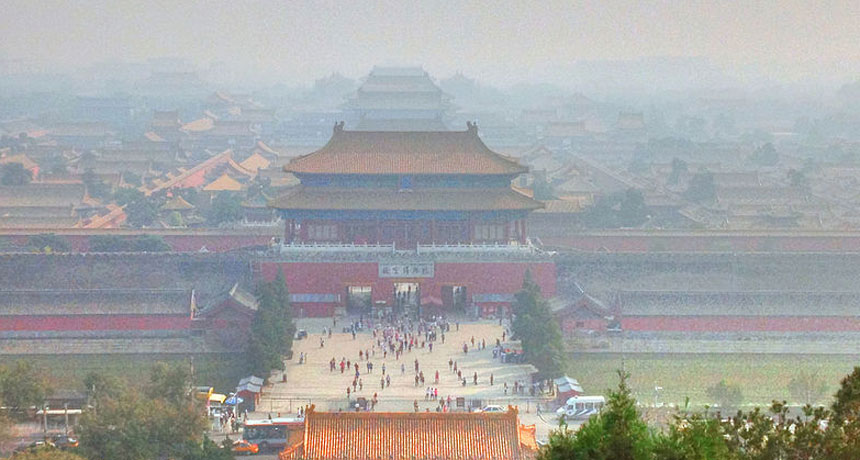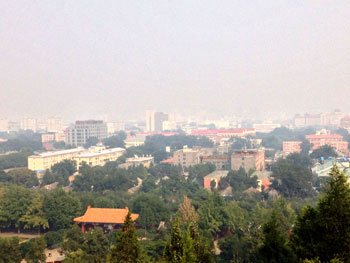Tiny air pollutants are big, big killers
Tiny particles make air pollution the fourth leading cause of death worldwide

Haze shrouds parts of Forbidden City in Beijing, China. This pollution also threatens health.
Yinan Chen, www.goodfreephotos.com
WASHINGTON, D.C. — Air pollution is now the world’s fourth leading cause of early death. It killed some 5.5 million people in 2013 alone. And those numbers are only likely to grow, reports an international team of researchers. They just shared the grim news, here, at a major science meeting.
Air pollution includes many substances that can cause illness and death. The new research focused on one type known as particulates. These include tiny particles of soot, dust and metals along with droplets of acids and other chemicals.
“That air pollution is known to be a serious cause of a number of health effects,” says Michael Brauer. He’s an epidemiologist at Canada’s University of British Columbia, in Vancouver. Like detectives, Brauer and others in his field figure out what causes an illness and how to limit its spread.
Particulates come in many sizes. Those with diameters less than 10 micrometers (or 4 ten-thousandths of an inch) can enter the lungs. Studies have linked breathing these tiny particulates to heart disease, stroke, lung cancer, asthma and other diseases. The World Health Organization (WHO) says people should not breathe in levels that, on average, exceed 10 micrograms per cubic meter (3.5 ounces per 35 cubic feet) of air.
Certain people will find it hard to breathe when levels are even this low. But at higher levels, the risk increases that more and more people can sicken — even die. And levels of this pollution in the major cities of several countries, including China and India, often exceed WHO’s recommended limit. When it comes to the lungs and the heart, Brauer reports, “We’re seeing levels in these countries eight to 10 times higher than what we think, ultimately, people should [breathe].”
Digging into the data
Brauer was part of a team of researchers from 13 countries around the world, including the United States, China and India. To figure out what share of total deaths from a disease was due to breathing in particulates, they used statistics. Basically, they figured out how much this pollution increased the risk of death from different heart and lung diseases, based on pollutant levels measured in each country. Then they used that fraction together with data on death rates to calculate lives lost due to air pollution.
Together, indoor and outdoor air pollution caused 5.5 million early deaths in 2013, the team concluded. And 55 percent of those early deaths happened in just two countries — China and India.
Qiao Ma is a graduate student at Tsinghua University in Beijing, China. She used a computer to model — or simulate — the role of different sources of outdoor air pollution on rates of early deaths in her country. She also used this computer model to analyze likely trends 14 years from now.
First, Ma ran her model with particulates from all sources, such as soot, car emissions, industrial pollution and more. That told her how much gunk was in the air. Then she compared those levels with the risks they pose for various diseases.
Then Ma ran her model again and again. Each time, she took out one source of the pollution. For example, coal fuels many power plants and factories. To see what role coal-burning plays, Ma took that pollution out of the total going into her model. When she then ran the model again, she could see how it differed. This let her tease out the share of early deaths was due to coal burning.
Indeed, Ma reports, outdoor air pollution from coal was China’s biggest source of particulate-related harm. It caused 366,000 early deaths there in 2013. And if things don’t change a lot, coal will still be the biggest pollution problem in 2030, she says.
Things are different in India. Chandra Venkataraman is a chemical engineer at the Indian Institute of Technology in Mumbai. The biggest culprit in her country is the traditional burning of biomass, such as wood and dried dung, she found. These types of biomass tend to be burned in indoor stoves and kilns. Small scale farms in the country also burn lots of plant material as a way to deal with wastes or to clear fields.
Brauer, Ma and Venkataraman described their new findings on February 13. They presented them at the annual meeting of the American Association for the Advancement of Science. Their new work built on findings their groups had published in Environmental Science & Technology last month and in a December 2015 paper in The Lancet.
Looking toward the future
Deaths from air pollution will rise by 2030, the researchers say. India and some other countries are likely to increase their emissions as their population grows and burns more fossil fuels. And even if China’s emissions don’t increase, the average age of its people is rising. Older people are more likely to have diseases linked to particulates, such as heart disease, stroke and emphysema, Brauer notes.

Fortunately, there is good news, Brauer says: “We know the way forward, and we actually know how to solve this problem.” The way to do that, he says, is to pollute less.
Terry Keating is an environmental scientist. He works for the U.S. Environmental Protection Agency in Washington, D.C., and had no role in the new studies. He says he hopes the new data prompt countries to take action.
“The ranking of air pollution relative to other health risks is much higher than what had previously been estimated,” Keating notes. “Air pollution is important. And globally, it’s a major health risk.”
Power Words
(for more about Power Words, click here)
asthma A disease affecting the body’s airways,which are the tubes through which animals breathe. Asthma obstructs these airways through swelling, the production of too much mucus or a tightening of the tubes. As a result, the body can expand to breathe in air, but loses the ability to exhale appropriately. The most common cause of asthma is an allergy. It is a leading cause of hospitalization and the top chronic disease responsible for kids missing school.
biomass Matter that contains carbon and can be used as a fuel, especially in a power station for the generation of electricity. Plants are a kind of biomass.
chemical engineer A researcher who uses chemistry to solve problems related to the production of food, fuel, medicines and many other products.
computer model A program that runs on a computer that creates a model, or simulation, of a real-world feature, phenomenon or event.
data Facts and statistics collected together for analysis but not necessarily organized in a way that give them meaning. For digital information (the type stored by computers), those data typically are numbers stored in a binary code, portrayed as strings of zeros and ones.
dung The feces of animals, also known as manure.
emit To produce and release or send out. Things that are discharged from various sources are called emissions.
emphysema A disease that irreversibly damages the air sacs and small airways of the lungs making it hard to breathe. Its victims feel short of breath after even a little exertion. The damage prevents the lungs from fully exhaling old air. As that air gets trapped in the lungs, little room is left for the lungs to bring in new, oxygen-rich air.
engineer A person who uses science to solve problems. As a verb, to engineer means to design a device, material or process that will solve some problem or unmet need.
epidemiologist Like health detectives, these researchers figure out what causes a particular illness and how to limit its spread.
graduate student Someone working toward and advanced degree by taking classes and performing research. This work is done after the student has already graduated from college (usually with a four-year degree).
nanoparticle A small particle with dimensions measured in billionths of a meter.
particulates Also called particle pollution (or PM), this is a mixture of very tiny particles and droplets that can include soot, dust, metals, acids and a host of other chemicals. Particulates smaller than 10 micrometers (393 millionths of an inch) in diameter can be inhaled into the lung. Breathing in too much can lead to heart, lung and brain diseases.
pollutant A substance that taints something — such as the air, water, our bodies or products. Some pollutants are chemicals, such as pesticides. Others may be radiation, including excess heat or light. Even weeds and other invasive species can be considered a type of biological pollution.
statistics The practice or science of collecting and analyzing numerical data in large quantities and interpreting their meaning. Much of this work involves reducing errors that might be attributable to random variation. A professional who works in this field is called a statistician.
stroke (in biology and medicine) A condition where blood stops flowing to part of the brain or leaks in the brain.
World Health Organization An agency of the United Nations, established in 1948, to promote health and to control communicable diseases. It is based in Geneva, Switzerland. The United Nations relies on the WHO for providing international leadership on global health matters. This organization also helps shape the research agenda for health issues and sets standards for pollutants and other things that could pose a risk to health. WHO also regularly reviews data to set policies for maintaining health and a healthy environment.







